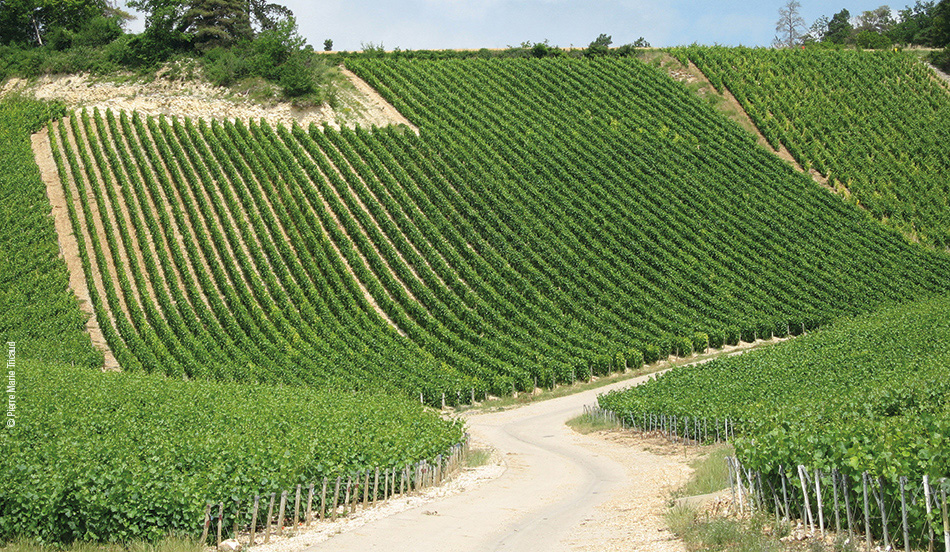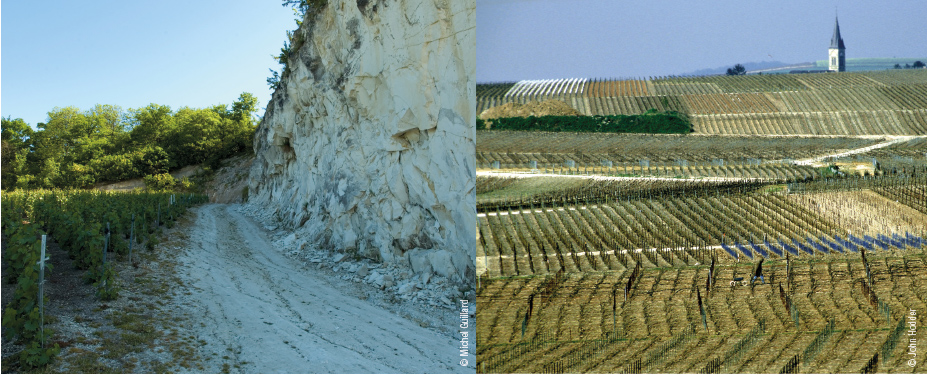
Superficie : 6 060 ha, 85 % chardonnay, 8 % meunier, 7 % pinot noir.
The Côte des Blancs is divided into 5 vineyard sectors along two coastlines. From southern Epernay to Villenauxe-la-Grande, the Côte de l'Ile-de-France represents the slope of the Brie plateau where the Côte des Blancs vineyards are located (eponymous sector), the Petit Morin valley which cuts into it, and the Cote du Sézannais. This irregular coastline has slopes that descend towards the plain in successive undulations and croups. The white chalk subsoil may be topped by slope colluvium (clayey silts, sands). The chalk is dated to the Campanian period (about 75 million years ago). The second line of relief is the Champagne coast, divided by the Marne and the Seine. The relief becomes gentler and the vineyard embraces the Vitryat and Montgueux sectors. The subsoil is respectively dominated by marly chalk (more clayey) topped in places by white chalk, and white chalk with clay and flint. The Côte des Blancs region's name can be traced back to its dominant grape variety, Chardonnay (white grapes with white juice), which enjoys the balance between a draining subsoil and east, south and southeast exposures.
Superficie : 12 108 ha, 59 % meunier, 23 % pinot noir, 18 % chardonnay.
The largest wine-growing region in the Champagne region stretches for almost 100 km along the two asymmetrical banks of the river Marne, passing through the Marne, Aisne and Seine-et-Marne departments. The sandy, clay, limestone and marl sediments, deposited from 65 million years ago, overlie the chalk which gradually disappears as it heads west from Epernay. The river Marne carved out its bed in the vast Brie plateau, followed by affluent streams which developed secondary valleys with well-defined vineyards. The wine region thus includes 6 sectors: Grande Vallée de la Marne (VDM), Coteaux Sud d'Epernay, VDM Rive Gauche, VDM Rive droite, Vallée du Surmelin, Vallée de la Marne Ouest. The Meunier grape variety can be found all over the hillside, but its later vegetative abilities have led it to be cultivated in cooler areas and on the lower, more clayey slopes. The more marly and chalky soils are given to Pinot Noir, while Chardonnay is grown in chalky soils with favourable exposure.

Superficie : 7 931 han 41 % pinot noir, 33 % meunier, 26 % chardonnay.
The Montagne de Reims vineyards are established on the Ile-de-France coast and on the Vesle and Ardre valleys. It intersects sediments deposited between 30 and 70 million years ago. To the north-west of Reims, the Meunier dominates the Massif de Saint-Thierry and the Vesle valley. It is located in small sandy-clay cirques to the east, or in sandy-clay-limestone valleys to the west. To the south-west of Reims, the Petite Montagne de Reims and the Ardre valley are characterised by hillsides cut into cirques with sandy-clay soils, where Meunier and Pinot Noir dominate. The Grande Montagne de Reims to the southeast of Reims is characterised by a hillside landscape, with exposures varying from west to southwest. The white chalk dominates, sometimes becoming very stony (gravelly) and allowing efficient natural drainage. There are also a few vineyards on chalky hillocks (Berru, Brimont) which express their porous, fluid and delicate chalk. Pinot Noir occupies well exposed chalky-clay soils, and sometimes sandy soils. The Meunier is dominant on the sandy clays and clayey sands. The Chardonnay occupies the sands and the chalk favourably exposed towards the east.
Superficie : 8 070 ha, 82 % pinot noir, 14 % chardonnay, 3 % meunier, 1 % autres cépages.
The Côte des Bar is a line of slopes cut into the Barrois plateau by the Seine, the Aube and all their tributaries, in the sediment formations containing fossils (in particular ammonites and Nanogyra virgula oysters) deposited about 150 million years ago in the Upper Jurassic. The Seine valley in the Aube department forms the Barséquanais sector, which is characterised by a more continental climatic influence and limestone and limestone-clay (marl) rocks. Pinot noir is the predominant grape variety and there is a historical presence of Pinot Blanc.
Geoffrey Orban